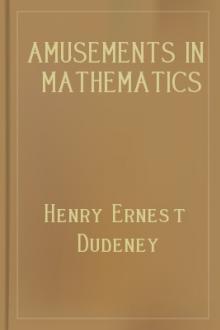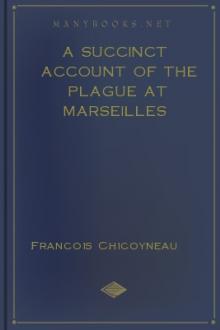Amusements in Mathematics, Henry Ernest Dudeney [books to read to be successful txt] 📗

- Author: Henry Ernest Dudeney
- Performer: 0486204731
Book online «Amusements in Mathematics, Henry Ernest Dudeney [books to read to be successful txt] 📗». Author Henry Ernest Dudeney
For the benefit of more advanced mathematicians I will add that the general expression for square pyramid numbers is (2n3 + 3n2 + n)/6. For this expression to be also a square number (the special case of 1 excepted) it is necessary that n = p2 - 1 = 6t2, where 2p2 - 1 = q2 (the "Pellian Equation"). In the case of our solution above, n = 24, p = 5, t = 2, q = 7.
139.—THE DUTCHMEN'S WIVES.—solution
The money paid in every case was a square number of shillings, because they bought 1 at 1s., 2 at 2s., 3 at 3s., and so on. But every husband pays altogether 63s. more than his wife, so we have to find in how many ways 63 may be the difference between two square numbers. These are the three only possible ways: the square of 8 less the square of 1, the square of 12 less the square of 9, and the square of 32 less the square of 31. Here 1, 9, and 31 represent the number of pigs bought and the number of shillings per pig paid by each woman, and 8, 12, and 32 the same in the case of their respective husbands. From the further information given as to their purchases, we can now pair them off as follows: Cornelius and Gurtrün bought 8 and 1; Elas and Katrün bought 12 and 9; Hendrick and Anna bought 32 and 31. And these pairs represent correctly the three married couples.
The reader may here desire to know how we may determine the maximum number of ways in which a number may be expressed as the difference between two squares, and how we are to find the actual squares. Any integer except 1, 4, and twice any odd number, may be expressed as the difference of two integral squares in as many ways as it can be split up into pairs of factors, counting 1 as a factor. Suppose the number to be 5,940. The factors are 22.33.5.11. Here the exponents are 2, 3, 1, 1. Always deduct 1 from the exponents of 2 and add 1 to all the other exponents; then we get 1, 4, 2, 2, and half the product of these four numbers will be the required number of ways in which 5,940 may be the difference of two squares—that is, 8. To find these eight squares, as it is an even number, we first divide by 4 and get 1485, the eight pairs of factors of which are 1 × 1485, 3 × 495, 5 × 297, 9 × 165, 11 × 135, 15 × 99, 27 × 55, and 33 × 45. The sum and difference of any one of these pairs will give the required numbers. Thus, the square of 1,486 less the square of 1,484 is 5,940, the square of 498 less the square of 492 is the same, and so on. In the case of 63 above, the number is odd; so we factorize at once, 1 × 63, 3 × 21, 7 × 9. Then we find that half the sum and difference will give us the numbers 32 and 31, 12 and 9, and 8 and 1, as shown in the solution to the puzzle.
The reverse problem, to find the factors of a number when you have expressed it as the difference of two squares, is obvious. For example, the sum and difference of any pair of numbers in the last sentence will give us the factors of 63. Every prime number (except 1 and 2) may be expressed as the difference of two squares in one way, and in one way only. If a number can be expressed as the difference of two squares in more than one way, it is composite; and having so expressed it, we may at once obtain the factors, as we have seen. Fermat showed in a letter to Mersenne or Frénicle, in 1643, how we may discover whether a number may be expressed as the difference of two squares in more than one way, or proved to be a prime. But the method, when dealing with large numbers, is necessarily tedious, though in practice it may be considerably shortened. In many cases it is the shortest method known for factorizing large numbers, and I have always held the opinion that Fermat used it in performing a certain feat in factorizing that is historical and wrapped in mystery.
140.—FIND ADA'S SURNAME.—solution
The girls' names were Ada Smith, Annie Brown, Emily Jones, Mary Robinson, and Bessie Evans.
141.—SATURDAY MARKETING.—solution
As every person's purchase was of the value of an exact number of shillings, and as the party possessed when they started out forty shilling coins altogether, there was no necessity for any lady to have any smaller change, or any evidence that they actually had such change. This being so, the only answer possible is that the women were named respectively Anne Jones, Mary Robinson, Jane Smith, and Kate Brown. It will now be found that there would be exactly eight shillings left, which may be divided equally among the eight persons in coin without any change being required.
142.—THE SILK PATCHWORK.—solution

Our illustration will show how to cut the stitches of the patchwork so as to get the square F entire, and four equal pieces, G, H, I, K, that will form a perfect Greek cross. The reader will know how to assemble these four pieces from Fig. 13 in the article.
143.—TWO CROSSES FROM ONE.—solution
It will be seen that one cross is cut out entire, as A in Fig. 1, while the four pieces marked B, C, D and E form the second cross, as in Fig. 2, which will be of exactly the same size as the other. I will leave the reader the pleasant task of discovering for himself the best way of finding the direction of the cuts. Note that the Swastika again appears.

The difficult question now presents itself: How are we to cut three Greek crosses from one in the fewest possible pieces? As a matter of fact, this problem may be solved in as few as thirteen pieces; but as I know many of my readers, advanced geometricians, will be glad to have something to work on of which they are not shown the solution, I leave the mystery for the present undisclosed.
144.—THE CROSS AND THE TRIANGLE.—solution
The line A B in the following diagram represents the side of a square having the same area as the cross. I have shown elsewhere, as stated, how to make a square and equilateral triangle of equal area. I need not go, therefore, into the preliminary question of finding the dimensions of the triangle that is to equal our cross. We will assume that we have already found this, and the question then becomes, How are we to cut up one of these into pieces that will form the other?
First draw the line A B where A and B are midway between the extremities of the two side arms. Next make the lines D C and E F equal in length to half the side of the triangle. Now from E and F describe with the same radius the intersecting arcs at G and draw F G. Finally make I K equal to H C and L B equal to A D. If we now draw I L, it should be parallel to F G, and all the six pieces are marked out. These fit together and form a perfect equilateral triangle, as shown in the second diagram. Or we might have first found the direction of the line M N in our triangle, then placed the point O over the point E in the cross and turned round the triangle over the cross until the line M N was parallel to A B. The piece 5 can then be marked off and the other pieces in succession.

I have seen many attempts at a solution involving the assumption that the height of the triangle is exactly the same as the height of the cross. This is a fallacy: the cross will always be higher than the triangle of equal area.
145.—THE FOLDED CROSS.—solution

First fold the cross along the dotted line A B in Fig. 1. You then have it in the form shown in Fig. 2. Next fold it along the dotted line C D (where D is, of course, the centre of the cross), and you get the form shown in Fig. 3. Now take your scissors and cut from G to F, and the four pieces, all of the same size and shape, will fit together and form a square, as shown in Fig. 4.

146.—AN EASY DISSECTION PUZZLE.—solution

The solution to this puzzle is shown in the illustration. Divide the figure up into twelve equal triangles, and it is easy to discover the directions of the cuts, as indicated by the dark lines.
147.—AN EASY SQUARE PUZZLE.—solution

The diagram explains itself, one of the five pieces having been cut in two to form a square.
148.—THE BUN PUZZLE.—solution

The secret of the bun puzzle lies in the fact that, with the relative dimensions of the circles as given, the three diameters will form a right-angled triangle, as shown by A, B, C. It follows that the two smaller buns are exactly equal to the large bun. Therefore, if we give David and Edgar the two halves marked D and E, they will have their fair shares—one quarter of the confectionery each. Then if we place the small bun, H, on the top of the remaining one and trace its circumference in the manner shown, Fred's piece, F, will exactly equal Harry's small bun, H, with the addition of the piece marked G—half the rim of the other. Thus each boy gets an exactly equal share, and there are only five pieces necessary.
149.—THE CHOCOLATE SQUARES.—solution

Square A is left entire; the two pieces marked B fit together and make a second square; the two pieces C make a third square; and the four pieces marked D will form the fourth square.
150.—DISSECTING A MITRE.—solution
The diagram on the next page shows how to cut into five pieces to form a square. The dotted lines are intended to show how to find the points C and F—the only difficulty. A B is half B D, and A E is parallel to B H. With the point of the compasses at B describe the arc H E, and A E will be the distance of C from B. Then F G equals B C less A B.
This puzzle—with the added condition that it shall be cut into four parts of the same size and shape—I have not been able to trace to an earlier date than 1835. Strictly speaking, it is, in that form, impossible of solution; but I give the answer that is always presented, and that seems to satisfy most people.

We are asked to assume that the two





Comments (0)